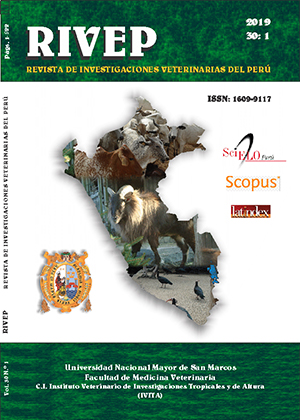Thermobiology of Bothrops asper (Garman, 1883) in Colombia: ecophysiological tests
DOI:
https://doi.org/10.15381/rivep.v30i1.15673Keywords:
mapaná; temperature; respiration; defense; feeding; responseAbstract
The optimal temperature range (RTO) and critical temperatures (CTmax, CTMin) of the respiratory rate (TR), and feeding (CA) and self-defence (CD) behaviour of Bothrops asper in captivity conditions were determined. Adult snakes (n=10) with a size of 137.2±17.2 cm and weight of 829.0±378.9 g were used and subjected to experimental temperatures between 10 and 40 °C and gradual changes of 3 °C per minute, except for catching their feed (4 °C per week). The RTO was between 21 and 31 °C for TR (22.9±5.1 resp/min), 27 to 31 °C and 26 to 30 °C for CA and CD, respectively. CTmax and CTMin were 39 °C and 15.5 °C for TR, 34.7 °C and 20 °C for CA and 33 °C and 21.7 °C for CD, respectively. Temperatures and ecophysiological variables were correlated in most cases (R=0.67, p=0.000), with a higher sensitivity to high thermal recordings. These data showed that temperature acts as a modulator of the events of the life history and the degree of intensity and succession of the physiological and behavioural processes of this viperid. The results also indicate that B. asper could not currently extend its geographic distribution range above 2000 m. Finally, a higher threat level (near threatened –NT–) is suggested for this species.
Downloads
Downloads
Published
Issue
Section
License
Copyright (c) 2019 Óscar Daniel Medina-Barrios, Éver Edrey Hernández-Cuadrado, Douglas Hernández Vélez

This work is licensed under a Creative Commons Attribution-NonCommercial-ShareAlike 4.0 International License.
AUTHORS RETAIN THEIR RIGHTS:
a. Authors retain their trade mark rights and patent, and also on any process or procedure described in the article.
b. Authors retain their right to share, copy, distribute, perform and publicly communicate their article (eg, to place their article in an institutional repository or publish it in a book), with an acknowledgment of its initial publication in the Revista de Investigaciones Veterinarias del Perú (RIVEP).
c. Authors retain theirs right to make a subsequent publication of their work, to use the article or any part thereof (eg a compilation of his papers, lecture notes, thesis, or a book), always indicating the source of publication (the originator of the work, journal, volume, number and date).










